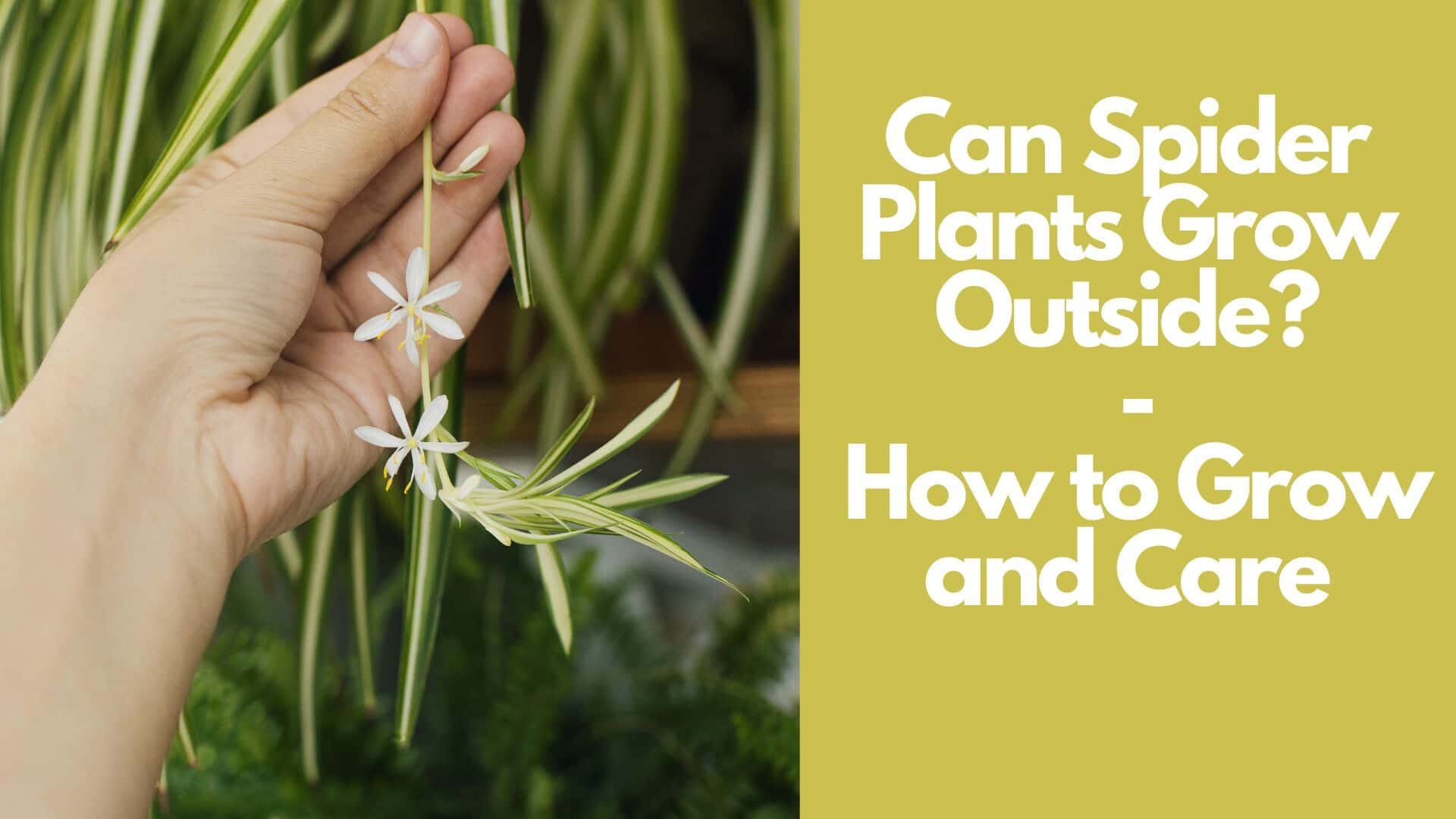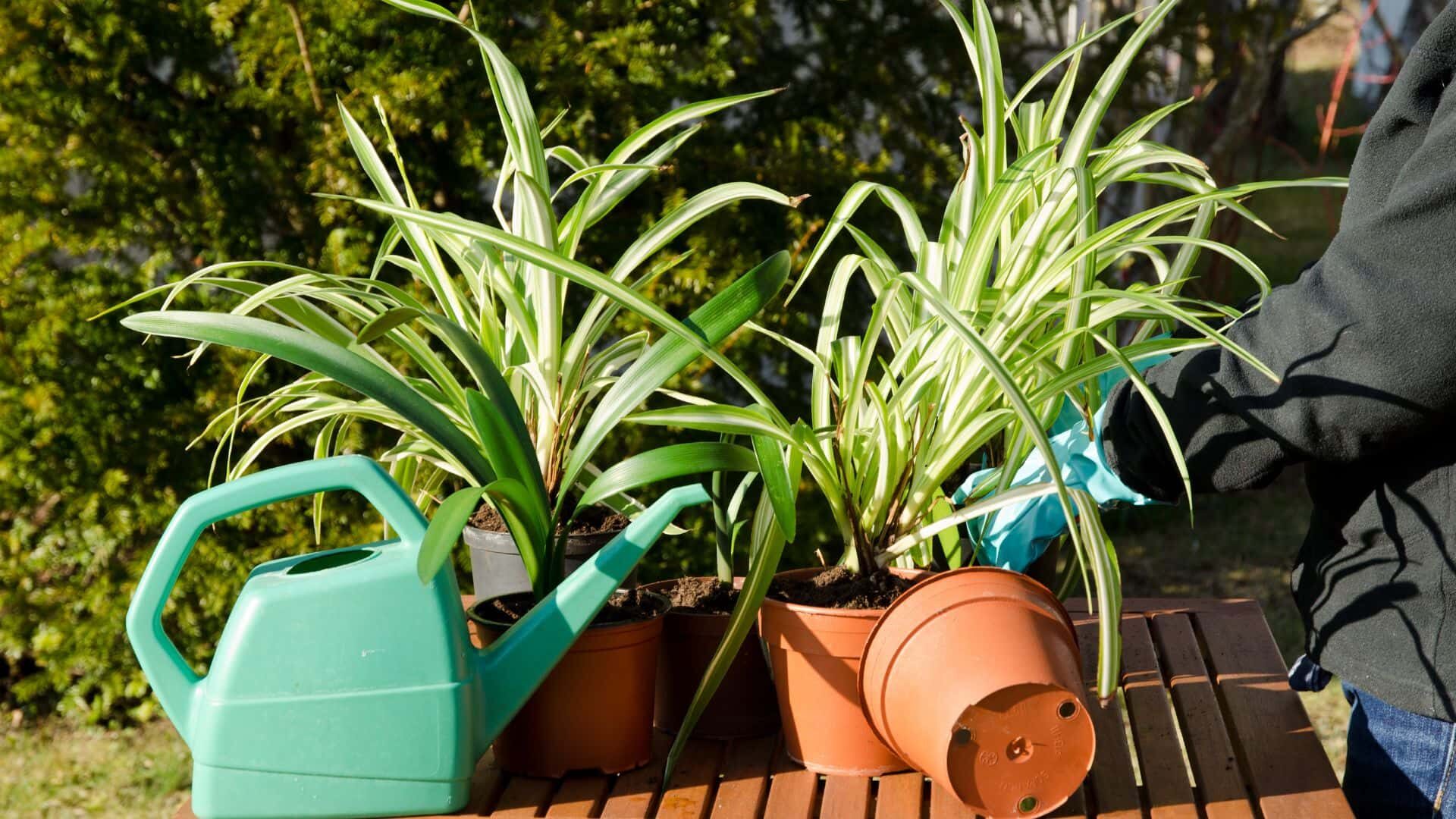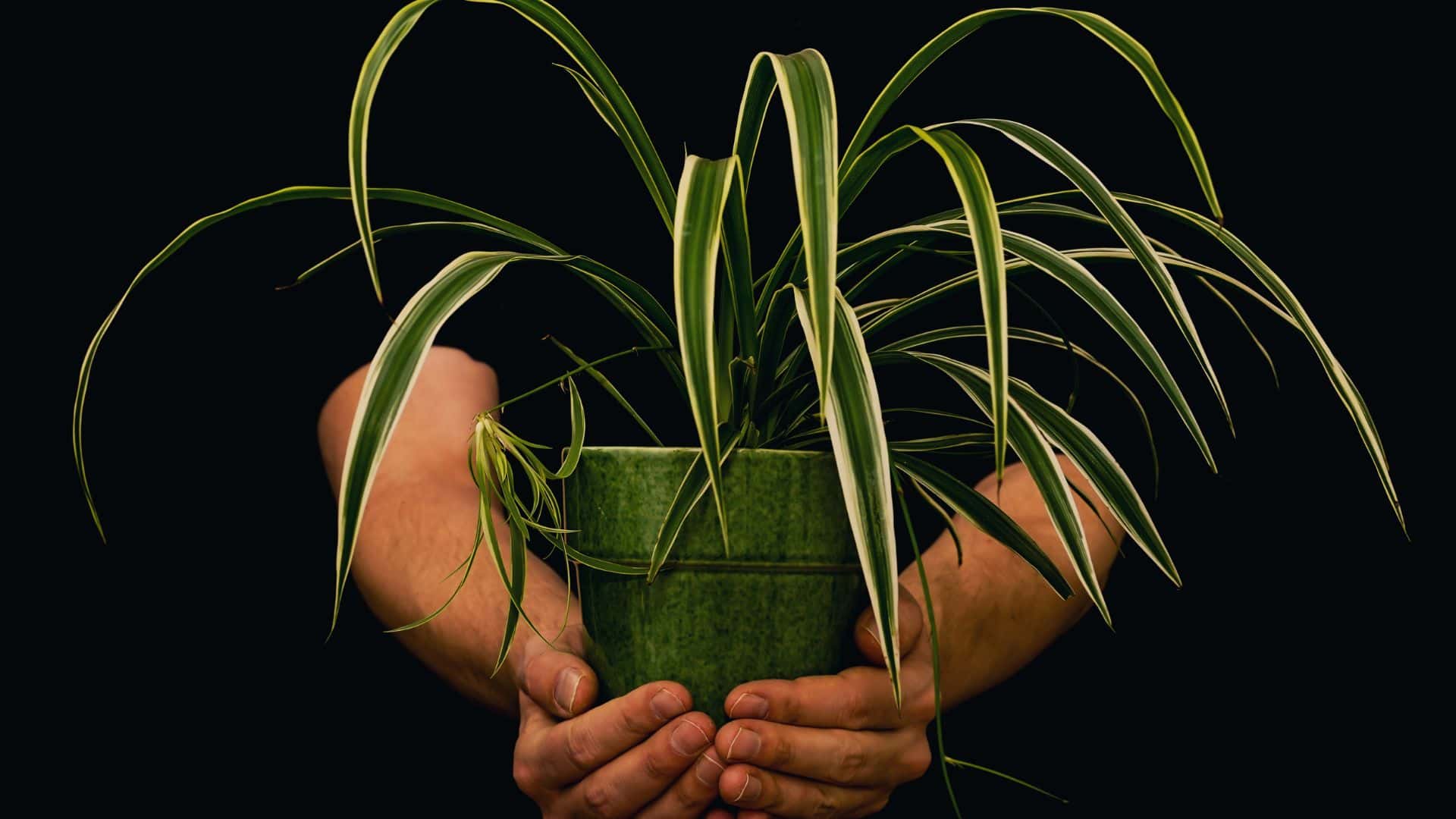Spider Plants (Chlorophytum Camosun) typically grow indoors. Common names for these plants include spider ivy and airplane plants. The leaves on these plants are what give them their other common name. Spider plants can produce offsets (also known as “pups”) and tiny white blooms on long stems during the summer. The plant got its name because the newborns resemble small spiders.
These plants are perfect for the home and make a lovely accent to any decor. Because of their resilience and adaptability, spider plants are great for novice gardeners. One of the best things about them is how simple they are to cultivate and enjoy.
They use because of their effectiveness in purifying indoor air. The spiderlike plantlets (spiders) that form on the flower stalks facilitate their rapid propagation. In a short time, a single spider plant can multiply into a large colony. A natural question to ponder is whether or not spider plants can survive in the great outdoors. Sure, spider plants can thrive in outdoor environments. By reading this guide, you will be able to know, Can Spider Plants Grow Outside? : How to Grow and Care.

Let’s start,
Can you grow spider plants outside?
Do not forget that Spider Plants are endemic to South Africa. When left to their own devices, they once thrived in the wild. These plants are native to the outdoors and had to be acclimatized to life indoors by humans.
These plants are tropical and require a warm environment to thrive. They thrive best in low environments, which are not always accessible. Only in zones, 9 to 11 can spider plants grow as perennials. However, they can grow as annuals under slightly more excellent temperate conditions.
Bear in mind that these plants will perish if exposed to even a slight frost. Plant them after the last frost date in your area if you want to grow them as annuals. It is a crucial element in a plant’s growth environment. For this reason, many individuals who wish to enjoy the benefits of a Spider Plant in their home grow them in containers, move them outside during the warmer months, and then bring them back inside once the temperature drops. Spider plants are easy to grow in zones 10 and 11.
How to grow spider plants outside?
The spider plant is an easy-to-care-for plant that can grow well outside. If you follow the proper steps in planting and caring for your spider plants, you can have a stunning landscape. Here, we talk about how to grow a spider plant outdoors in a pot and on the ground.
How to grow spider plants in a container?
When conditions are right, spider plants thrive in hanging baskets placed outside. The plant has small white flowers that look like stars and hang from long flower stalks. For your landscape, this may make a stunning display.
To successfully grow a spider plant in a pot or hanging basket for outdoor use, you’ll need to select a container with a diameter of at least 12 inches and numerous drainage holes. Spider plants can grow in various locations outdoors. You can put them under the shade of a big tree, on your porch, patio, or just next to the path.
If you want to keep your spider plant alive and well, you must ensure it doesn’t get too much direct sunshine. Because it prefers loamy, well-drained soil, spider plants make excellent container plants.
If the top inch of soil appears dry to the touch, it’s time to give the plant a drink. Apply a balanced fertilizer (such as 10-10-10) during the summer and every other month during the winter.
How to grow spider plants in the ground?
You’ll want to plant them in an area of your garden where they’ll have plenty of room to flourish as they expand rapidly and aggressively.
Spider plants are adaptable and may thrive in various soil conditions, but they do best in nutrient-rich, well-drained soil. When looking for a place to plant, stay away from areas where the soil stays wet for a long time.
Before potting your spider plant, ensure the hole is at least twice as large as the pot it came in. Be sure there are no air gaps around the root by packing the dirt tightly. Be sure to give the plant plenty of water and a balanced fertilizer once a month.
What kind of soil is ideal for outdoor spider plants?
Outside, well-drained soil is ideal for your spider plant. Soil with a high percentage of sand or gravel will drain water fast, protecting plant roots from rot. Sand or perlite can add to ordinary soil in place of sandy or gravelly soil.
How much sun should receive the spot?
They only need pretty small amounts of most of what helps them grow. Spider plants need bright but indirect light to thrive.
The tips of their leaves might turn brown if subjected to too much direct sunshine or heat.
What should you do with spider plants when it is cold outside?
You should start new plants in individual containers and bring them inside before the first frost. Ensure this when the weather is correct because these plants need to grow in warm places. Similarly, please get them back inside when the temperature drops below freezing.
If you do this, you can enjoy a lovely Spider Plant in your garden during the warm months and then bring it inside during the cooler months.
Can you put indoor spider plants outside to grow?
Spider plants need to be moved cautiously from indoors to outdoors. You shouldn’t uproot your spider plant and suddenly move it to a new location.
The plant’s health is affected by a small number of other elements beyond the transition environmental factors, such as climate, lighting, humidity, and so on. Since we have no say over the world beyond our walls, we must ensure everything is in order before taking action.
How to move indoor spider plants outside?
Your spider plant must relocate carefully to avoid damaging its roots and stunting its growth. Follow these guidelines to ensure a stress-free and orderly transition.
- Briefly place your spider plant outside under a shade for a few hours and bring them back in.
- For the following few days, do this, gradually increasing their time outdoors by a few hours each day.
- After moving them in and out under the shade for a few days, you need to move them under the morning/evening sun for a few hours.
- Continuing the same technique for a few more days will acclimate the spider plant to new lighting conditions.
- They can now spend the whole day and night in the open air without worry.
How to care for outdoor spider plants?
Spider plants can be just as easy to cultivate outside as indoors. Several things can affect a spider plant’s growth.
However, when housed in the great outdoors, surprises await. Maintaining spider plants in outdoor settings requires consideration of several critical criteria, including watering, exposure to sunlight, feeding and propagating, etc.

1. Watering
It’s preferable to water your outdoor spider plant first thing in the morning or after dark. Water the plant well, ensuring all the water evaporates before watering.
During the summer, spider plants need only a minimal amount of water, and they thrive when exposed to natural rainfall. Natural rainfall is preferable for spider plants because it does not contain harmful chemicals like fluoride or chlorine.
Ensure there are no pools of water in the container or soil. Maintain wet soil, but cut back in late autumn to avoid overwatering during dry or hot periods. Regular spraying of the spider plant in drier climates recommends maintaining an ideal humidity level.
2. Exposure to Sunlight
Light conditions don’t bother spider plants too much. It’s vital to notice that variegated plants lose their variegation under lower light levels since they need to produce more chlorophyll to gather adequate light and that direct sunlight will burn the sensitive leaves.
The plant prefers partial shade, so a porch roof is perfect, but an ivy-covered trellis or other shade structure would do just fine.
What happens if you receive full sunlight to spider plants?
It’s not true that you can grow spider plants outside in the sun. Your spider plant’s leaves may brown by direct sunshine, but the remaining crisp foliage will look great. Ensure you always protect these plants from direct sunlight by placing them in a shady area or beneath a tree.
3. Propagation
All spider plants can quickly propagate in the garden by separating established clumps. Using a shovel, delicately unearth the plant and divide it into various sections.
Spider plants can also propagate using cuttings taken from the mother plant. You should remove all but the top two or three leaves off the mother plant’s stem that you cut and trim it to a length of 6 inches. Dip the stem in rooting hormone powder and set it in damp soil. Then, place the container in indirect sunlight and water it frequently. New roots will begin to form after a few weeks, at which point you can plant your spider plant outdoors.
4. Fertilizing
For your spider plant to thrive in the wild, you must provide it with the nutrients it needs. The spider plant will have everything it needs for optimal growth if you use a balanced fertilizer with nitrogen, phosphate, and potassium in equal proportions. In the summer, fertilize your spider plant once a month, and in the winter, every other month.
Fertilizers with high fluoride or boron concentrations are not good choices since they can kill the plant. Using a simple 10-10-10 fertilizer once a month or every two months is optimal. Don’t go adding more fertilizer than that.
5. Temperature
The growth of spider plants is sensitive to temperature. Most tropical plants, like most people, do best with low to moderate levels of mercury.
Temperature changes might be stressful for the spider plant kept indoors. There are different factors to consider before locating your spider plant outside.
What is the temperature level best to grow spider plants outdoors?
Spider plants are tough and can survive in a wide range of temperatures. A spider plant does well in temperatures ranging from around 65⁰F to about 90F⁰.
For optimal development, maintain a mercury temperature of at least 60⁰F. Despite mercury dropping as low as 40⁰F, the facility will be unchanged. However, we must keep it from happening since it places unnecessary strain on the plant.
Although the plant is not affected by mild temperature changes, if subjected to an unfavorable temperature for an extended period, it may suffer severe consequences.
6. Insects/ Pests Prevention
It’s important to remember that Spider Plants if kept outside, might attract unwanted pests. Scale, aphids, spider mites, and whiteflies are the most prevalent insect pests that prey on Spider Plants. To get rid of these bugs, apply insecticidal soap.
It is crucial if you keep your Spider Plant in a container and intend to bring it indoors for the winter. You can create your effective insecticide using only a soap dish, some mouthwash, and some water.
5 Best Spider Plant Varieties to Grow
Although most spider plants are known for their shiny green leaves, there are several varieties available that vary solely in size, leaf shape, and leaf color. Here, we’ll include some of the most common outdoor-adapted spider plant kinds.
1. Variegated Spider Plant
The Chlorophytum comosum Vittatum is the most widely grown species of perennial spider plant. Medium green in color, with gently curved edges and broad, creamy vertical stripes, the leaves of this spider plant variety are distinctive. It can grow to be between 1 and 2 feet long and wide.
2. Reverse the Spider Plant
This spider plant is scientifically known as Chlorophytum comosum ‘Reverse Variegatum’. The plant’s name suggests that the leaves’ margins and centers are solid colors rather than the usual stripes or patterns in variegated varieties. The leaves are forest green inside and have a gentle yellow border. This spider plant is an excellent way to diversify your landscape and may reach impressive proportions if given enough room.
3. Bonnie Spider Plant
The bonnie plant, number four on our list, unfurls its coiled leaves and produces new plants. The bonnie spider plant is similar to the variegated spider plant due to its spiral leaves.
The bonnie spider plant’s long, curled, and brighter leaves are what drive up its price. Smaller rooms and balconies are ideal for this.
4. Hawaiian Spider Plant
Hawaiian spider plants are among the smallest and most compact of all spider plants. Glossy green leaves cover the ground, and clusters of tiny new plants grow on runners that spread out from the parent plant.
Its maximum height is around 15 centimeters (about 6 inches), and its full width is about 30 centimeters (12 inches).
5. Curly Spider Plant
Like the Bonnie variety, curly spider plants have curly leaves, as the name implies. The leaves have a curly appearance because they twist and overlap.
That plant thrives in full or partial sunlight and looks great when hung in a decorative container. Curly spider plants thrive in warmer and drier environments, making them ideal houseplants.
Watch how to propagate spider plant in 3 ways | Video
Top 5FAQS & answers related to Can spider plants grow outside? : how to grow and care
Can spider plants grow in the shade?
Spider plants can survive in summer shade but do best in bright, indirect light. Place your spider plant in a sunny window or under grow lights to encourage development throughout the winter months.
Is the spider plant lucky?
The spider plant symbolizes good fortune and health in eastern culture. Mainly because the natural, vigorous, and long vines of the Spider Plant will grow to represent stability in life. They are one of the most widely grown houseplants for those seeking good fortune.
Will the spider plants move outside at a particular time?
You can probably move the spider plant outside if you live in a warm and sunny area. You can take your spider plant out whenever you like, as long as the weather is mild.
Are coffee grounds good for spider plants?
A spider plant’s ideal soil pH ranges from 6.1 to 6.5, and soil occasionally receives diluted coffee is beneficial. We suggest using a ratio of one part coffee to three parts water.
How large do spider plants get when planted outdoors?
When grown from seed in the soil, spider plants can reach a height of 2 feet and a width of 3 feet. You can control how quickly your spider plant grows by periodically removing the top third of the plant. To prevent it from becoming too massive, do this.
Conclusion
By reading this guide, I hope you got the full idea of Can Spider Plants Grow Outside: How to Grow and Care Guide.
Please share this Can Spider Plants Grow Outside: How to Grow and Care Guide with your friends and do a comment below about your feedback.
We will meet you on next article.
Until you can read, How to Use Epsom Salt for Cucumbers: Guide with Tips
